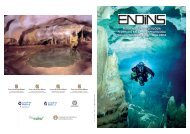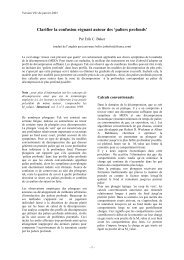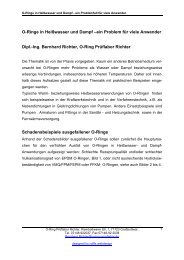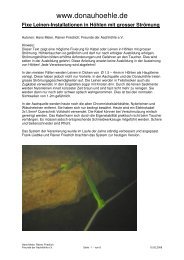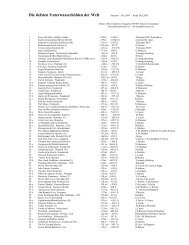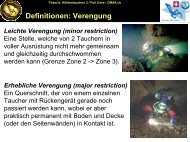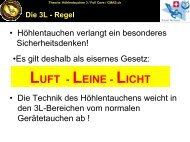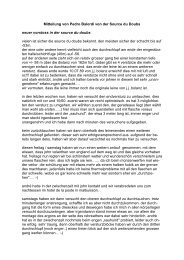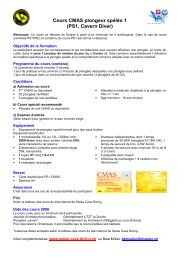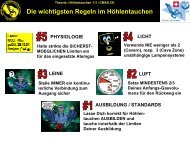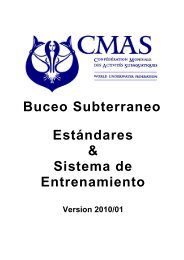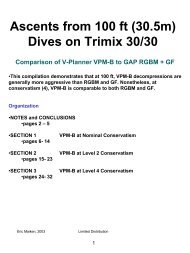cave diving and the nss - bei Swiss-Cave-Diving
cave diving and the nss - bei Swiss-Cave-Diving
cave diving and the nss - bei Swiss-Cave-Diving
You also want an ePaper? Increase the reach of your titles
YUMPU automatically turns print PDFs into web optimized ePapers that Google loves.
54 CAVE DIVING COMMUNICATIONS 55<br />
Bridging a gap<br />
Begin by using <strong>the</strong> loop in <strong>the</strong> gap reel to install a line-to-line connection.<br />
It is best to install this connection a few inches away from <strong>the</strong> permanent-line<br />
tie-oft. This allows for a clean, unencumbered attachment of <strong>the</strong> gap reel to <strong>the</strong><br />
permanent guideline. After bridging <strong>the</strong> gap, respool any excess line, <strong>the</strong>n lock off<br />
<strong>the</strong> gap reel. Make two wraps around <strong>the</strong> new permanent line with <strong>the</strong> gap reel,<br />
<strong>the</strong>n clip off <strong>the</strong> gap reel in <strong>the</strong> direction of travel.<br />
CAVE DIVING AND<br />
THE NSS<br />
Founded in 1941, <strong>the</strong> National Speleological Society (NSS) joins<br />
toge<strong>the</strong>r thous<strong>and</strong>s of individuals dedicated to <strong>the</strong> safe study, exploration,<br />
<strong>and</strong> conservation of <strong>cave</strong>s. As a nonprofit organization affiliated with <strong>the</strong><br />
American Association for <strong>the</strong> Advancement of Science, <strong>the</strong> NSS promotes<br />
a variety of scientific, educational, <strong>and</strong> conservation projects—including<br />
grants <strong>and</strong> scholarships to professional <strong>and</strong> student biologists, geologists,<br />
hydrologists, <strong>and</strong> archaeologists for <strong>cave</strong>-related research; purchase of<br />
<strong>cave</strong> properties for <strong>the</strong> public trust; conservation studies, clean-ups, <strong>and</strong><br />
restorations; a nationwide rescue-<strong>and</strong>-recovery network; <strong>and</strong> a multitude<br />
of publications concerning all aspects of <strong>cave</strong> science, exploration, survey,<br />
cartography, photography, <strong>and</strong> physical techniques.<br />
The first <strong>cave</strong>-<strong>diving</strong> information ever published in <strong>the</strong> United States<br />
was in a 1947 NSS Bulletin. In 1948, NSS divers were responsible for<br />
<strong>the</strong> first <strong>cave</strong> dives in <strong>the</strong> United States using scuba. In 1953, <strong>the</strong> Florida<br />
Speleological Society (a local NSS subsection or "grotto") conducted <strong>the</strong><br />
first <strong>cave</strong>-diver training course, complete with written st<strong>and</strong>ards. In 1968<br />
an NSS member authored <strong>the</strong> first American manual on <strong>cave</strong> <strong>diving</strong>. By<br />
1973, in response to a growing need to address <strong>the</strong> particular needs of<br />
<strong>cave</strong> divers, <strong>the</strong> NSS formed <strong>the</strong> <strong>Cave</strong> <strong>Diving</strong> Section (NSS-CDS). In<br />
1983 <strong>the</strong> <strong>Cave</strong> <strong>Diving</strong> Section was independently incorporated <strong>and</strong> in<br />
1987 was granted official IRS nonprofit tax-exempt status as a scientific<br />
<strong>and</strong> educational organization.<br />
The NSS-CDS has <strong>the</strong> largest <strong>cave</strong>rn- <strong>and</strong> <strong>cave</strong>-<strong>diving</strong> training program<br />
in <strong>the</strong> world, <strong>and</strong> is a leader in setting <strong>cave</strong>-<strong>diving</strong> st<strong>and</strong>ards for <strong>the</strong><br />
rest of <strong>the</strong> <strong>diving</strong> community. The NSS-CDS was <strong>the</strong> first to institute <strong>the</strong><br />
concept of <strong>cave</strong>rn-<strong>diving</strong> training, <strong>and</strong> has certified more than 7000<br />
<strong>Cave</strong>rn <strong>and</strong> <strong>Cave</strong> Divers. In addition, <strong>the</strong> NSS-CDS has a comprehensive<br />
instructor training program.<br />
The NSS <strong>Cave</strong> <strong>Diving</strong> Section has also trained more than 500 <strong>Cave</strong><br />
<strong>Diving</strong> Rescue/Recovery Specialists. In cooperation with <strong>the</strong> National<br />
Association for Search <strong>and</strong> Recovery (NASAR), <strong>the</strong> National <strong>Cave</strong> Rescue<br />
Commission (NCRC), <strong>and</strong> <strong>the</strong> National Crime Information Center<br />
(NCIC), <strong>the</strong>se <strong>Cave</strong> <strong>Diving</strong> Rescue/Recovery Specialists are made available<br />
to law-enforcement agencies that are affected by underwater-<strong>cave</strong>related<br />
rescues <strong>and</strong> recoveries. The team of <strong>cave</strong> divers is available 24<br />
hours a day. NSS-CDS members have performed numerous rescues <strong>and</strong><br />
recoveries throughout <strong>the</strong> United States <strong>and</strong> at <strong>the</strong> request of several



